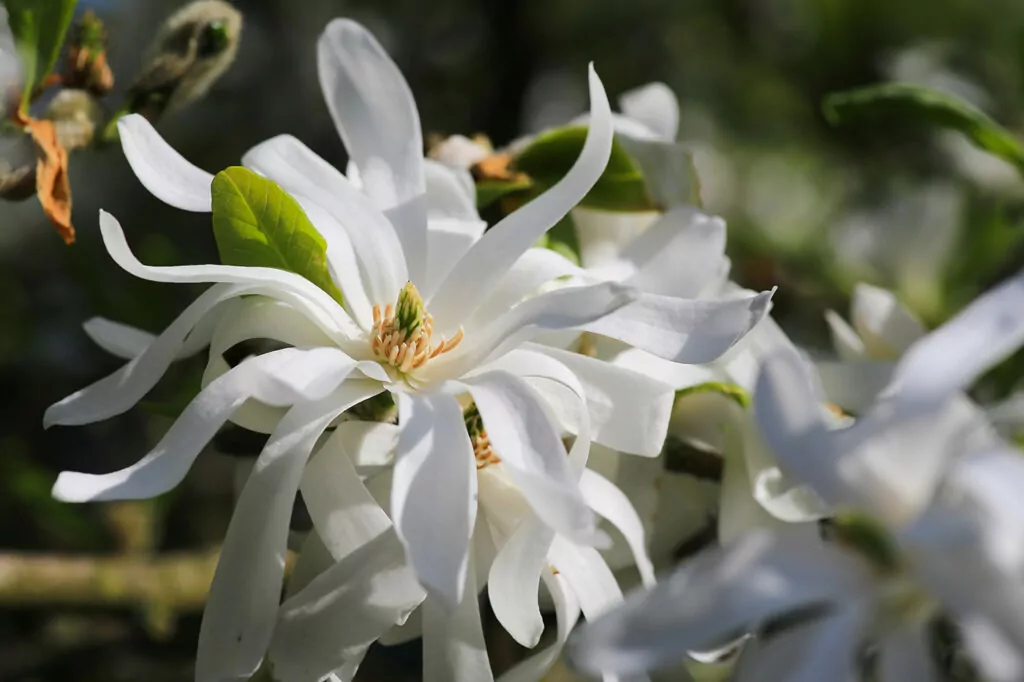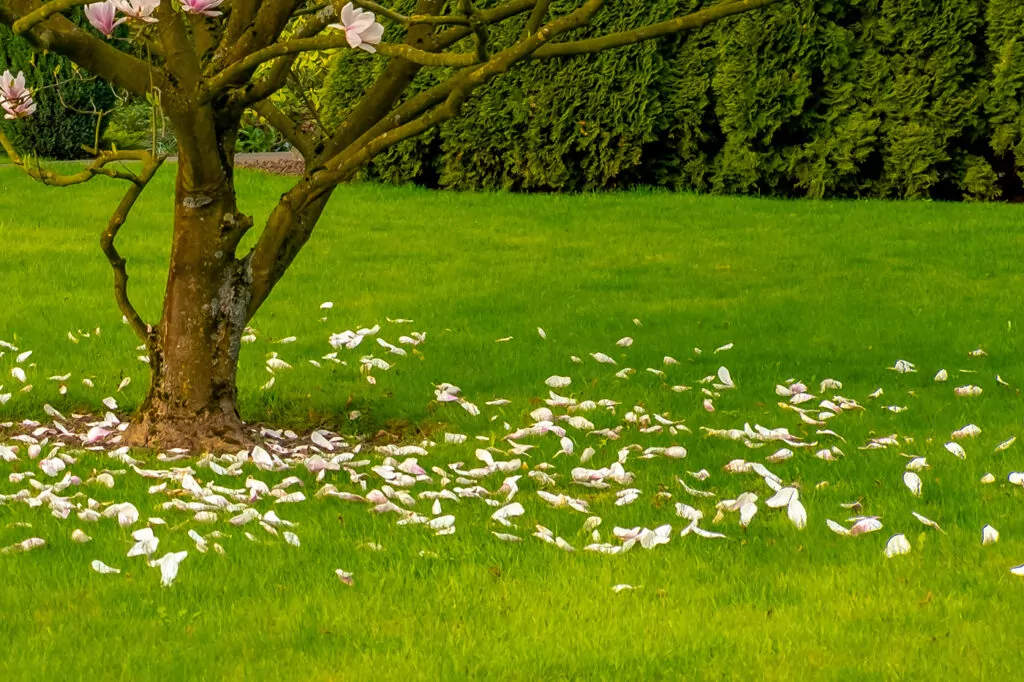Magnolias are a captivating genus of flowering trees, boasting a rich history and legendary beauty. They grace landscapes across the globe, offering a touch of elegance with their fragrant blooms and lush foliage. Whether you’re drawn to the grandeur of the Southern Magnolia (Magnolia grandiflora) or the delicate charm of the Star Magnolia (Magnolia stellata), these captivating trees—not to be confused with tulip trees—add a touch of magic to any garden.
This comprehensive guide delves into the world of magnolia tree care, equipping you with the knowledge to plant, nurture, and cultivate these magnificent plants. We’ll explore the different magnolia tree types, delve into planting and growing techniques, answer the question “Where do magnolias grow?”, and provide essential tips for ongoing care.
Types of Magnolias

There are two main magnolia tree types: evergreen and deciduous. Understanding these distinctions is crucial for choosing the perfect variety for your garden.
Evergreen Magnolias

Evergreen magnolias, as the name suggests, hold onto their glossy green leaves year-round. These southern charmers are popular for their dense foliage, which provides year-long visual interest. They typically flower in late spring or early summer, showcasing fragrant tulip-like blooms in shades of white, cream, or yellow. Some magnolias also offer pink flowers.
Southern Magnolia (Magnolia grandiflora)
The Southern Magnolia tree is an iconic and quintessential evergreen magnolia. It boasts massive, fragrant white flowers and can reach heights of 80 feet or more.
Sweet Bay Magnolia (Magnolia virginiana)
A smaller and more compact option, the Sweet Bay Magnolia is prized for its culinary uses (its leaves are used as bay leaves) and its tolerance for wet soil. It features fragrant white flowers and grows to around 20-30 feet tall.
Deciduous Magnolias

Deciduous magnolias shed their leaves in the fall, offering a stunning display of autumn colors before revealing their bare branches in winter. They tend to flower earlier than their evergreen counterparts, typically blooming in early spring before they leaf out.
Star Magnolia (Magnolia stellata)

This beloved variety is known for its star-shaped white flowers that appear in late winter or early spring, often before the leaves emerge. It’s a smaller magnolia, reaching only 15-20 feet in height, making it a great choice for smaller gardens.
Saucer Magnolia (Magnolia x soulangeana)

A showstopper in the spring garden, the Saucer Magnolia features large, cup-and-saucer shaped blooms in shades of white, pink, or purple. It grows to around 20-30 feet tall and offers a captivating floral display.
Pro tip: You might be wondering: When do magnolias bloom? Blooming times can vary slightly depending on the specific variety and your climate. In general, evergreen magnolias tend to bloom in late spring or early summer, while deciduous magnolias flower in early spring before they leaf out. Once you know the answer to the question “When do magnolias bloom?”, choosing the right magnolia for your garden will involve considering two key factors: the health of the tree and the size it will reach at maturity.
How to Choose the Right Magnolia

When choosing a new magnolia tree, consider the following points.
Choosing the right tree: Look for a magnolia with a sturdy trunk and well-spaced branches. The magnolia leaves should be a healthy green color, free from any spots, discoloration, or insect damage. Avoid trees with broken branches, wounds on the trunk, or signs of disease.
Matching the magnolia to your garden size: Magnolias come in a wide range of sizes, from dwarf varieties suitable for containers to towering giants that can dominate a landscape. Before purchasing a magnolia, consider the mature size of the tree and ensure you have adequate space to accommodate its growth.
- Large gardens: If you have a spacious garden, you can opt for majestic varieties like the Southern Magnolia (Magnolia grandiflora) or the Saucer Magnolia (Magnolia x soulangeana). These trees can provide shade and a focal point in your landscape.
- Small gardens: For smaller gardens, consider compact varieties like the Star Magnolia (Magnolia stellata) or the Little Gem Magnolia (Magnolia x soulangeana ‘Little Gem’). These dwarf magnolias offer a beautiful floral display without overwhelming a limited space.
Thinking beyond size: While size is a crucial factor, also consider other aspects like:
- Light needs: Most magnolias prefer full sun to partial shade. However, some varieties, like the Sweet Bay Magnolia (Magnolia virginiana), can tolerate more shade.
- Bloom color: Magnolias come in a range of bloom colors, from classic white to soft pink and deep purple. Choose a color that complements your existing landscaping.
- Flowering time: Do you prefer a magnolia that blooms in early spring or late spring/early summer? Consider the flowering time when selecting a variety.
Unsure about choosing the perfect magnolia? Taskrabbit can connect you with experienced gardening Taskers who can help you assess your space, select the ideal magnolia variety, and ensure proper planting.
Once you’ve chosen the perfect magnolia for your garden, it’s time to plant and nurture it for success.
Planting and Growing Magnolias

You might now be wondering how to plant a magnolia tree. Below, we’ll cover not just the planting process but also how to grow a magnolia tree from a seed.
How and Where to Plant Magnolia Trees
If you’re wondering how to plant a magnolia tree, you should do the following:
- Decide on timing: The ideal time to plant a magnolia depends on the variety. Unlike many other deciduous trees, deciduous magnolias are best planted in early spring while they are dormant. Evergreen magnolias can be planted in spring or fall, but avoid planting during periods of extreme heat or cold.
- Choose a location: Choose a location that receives full sun to partial shade. Magnolias prefer well-drained and slightly acidic or alkaline soil, so avoid planting in areas with standing water.
- Dig the hole: Dig a hole that is at least 1.5 times wider than the root ball of the magnolia and slightly shallower than the depth of the root ball. Loosen the soil around the edges of the hole to encourage root growth.
- Plant the magnolia: Carefully remove the magnolia from its container, and gently loosen any compacted roots. Position the tree in the hole so that the root flare (the area where the trunk widens at the base) is slightly above the surrounding soil level.
- Fill the hole: Backfill the hole with the excavated soil, mixing in some compost or organic matter for improved drainage and nutrients. Tamp down the soil gently to remove air pockets.
- Water the tree: Water the newly planted magnolia tree thoroughly to settle the soil and hydrate the roots.
Now you might be wondering: Where do magnolias grow, and how do you ensure that they grow well? Read on for answers!
How to Grow Magnolia Trees

Growing magnolias from seed is a slow process that requires patience and specific conditions. It’s generally not recommended for beginners and has a lower success rate compared to planting container-grown trees.
But how do you grow a magnolia from a seed? Magnolias are native to various regions across North America and Asia, and different varieties have adapted to thrive in specific climates. Most magnolias prefer warm climates with mild winters, although some varieties can tolerate colder temperatures.
- Southern Magnolias (Magnolia grandiflora) and Sweet Bay Magnolias (Magnolia virginiana): These evergreen varieties prefer warm climates in the southern United States, from Florida to Texas, and up the Atlantic Coast to Virginia.
- Star Magnolias (Magnolia stellata) and Saucer Magnolias (Magnolia x soulangeana): These deciduous varieties can tolerate colder temperatures and are suitable for zones 4-9 on the USDA Hardiness Zone Map.
Planting a magnolia tree can be a rewarding experience, but it requires proper technique. If you’d prefer expert assistance, Taskrabbit connects you with skilled gardening Taskers who can handle the planting process for you, ensuring your magnolia gets off to a healthy start. And once your tree is ready, Taskers can also handle pruning your magnolia tree!
Proper Magnolia Tree Care
Now that your magnolia is planted, here’s how to provide the care it needs to thrive:
Light

- Most magnolias prefer full sun to partial shade. Aim for at least 6-8 hours of direct sunlight daily.
- Some varieties, like the Sweet Bay Magnolia (Magnolia virginiana), can tolerate more shade, but flowering may be less prolific.
Water

- Magnolias need consistent moisture, especially during their first few years after planting.
- Water deeply and regularly, allowing the soil to dry slightly between waterings.
- Avoid overwatering, which can lead to root rot.
- Water young trees deeply 2-3 times a week during hot weather.
- Water established trees deeply once a week during dry periods.
Soil

- Magnolias prefer well-drained, slightly acidic soil (pH 6.0-6.5).
- If your soil is heavy clay, amend it with compost or aged manure to improve drainage.
- If your soil is very alkaline (high pH), you may need to add sulfur to lower the pH level. A soil test can help determine your soil’s pH and nutrient content.
Mulch

- Apply a 2-3 inch layer of mulch around the base of the tree, but keep it away from the trunk to prevent rot.
- Mulch helps retain moisture, suppress weeds, and regulate soil temperature.
- Replenish the mulch layer annually as it decomposes.
Fertilizer

- Established magnolia trees generally don’t require heavy fertilization.
- You can provide a light feeding in early spring with a slow-release fertilizer formulated for flowering trees.
- Avoid over fertilizing, which can encourage excessive foliage growth at the expense of fragrant flowers.
Pruning Magnolia Trees

- Pruning magnolia trees is usually not essential for most types, but it can help maintain their shape and encourage flowering.
- The best time to prune magnolias is late winter or early spring before new growth emerges.
- Remove any dead, diseased, or damaged branches.
- For shaping purposes, aim for light pruning to avoid removing too many flower buds.
Propagation

Magnolias can be propagated through several methods, but these methods require specific techniques and experience. For most home gardeners, planting container-grown trees is the easiest and most successful option.
Cons of Magnolias

While magnolias offer undeniable beauty, there are a few potential drawbacks to consider:
- Large size: Some magnolia varieties can grow quite large, so ensure you have ample space to accommodate them at maturity.
- Shallow roots: Magnolias have shallow root systems, which can make them susceptible to damage from strong winds or nearby construction.
- Messy fallen leaves and flowers: Evergreen magnolias drop large glossy leaves year-round, while deciduous varieties shed both leaves and flowers in the fall. Be prepared for some cleanup.
- Susceptibility to pests and diseases: Magnolias can be susceptible to certain pests and diseases, such as scale, fungal diseases, and leaf spot. Regular monitoring and appropriate treatment are essential.
Magnolia tree care encompasses various tasks, from planting and mulching to pruning and pest control. If you need assistance with any aspect of magnolia tree care, Taskrabbit can connect you with experienced gardening Taskers who can plant, transplant, and trim your trees at affordable rates. Let Taskrabbit help you cultivate a flourishing magnolia that will grace your garden for generations to come.














